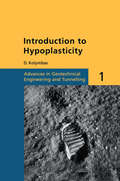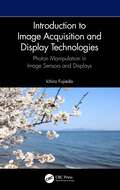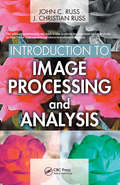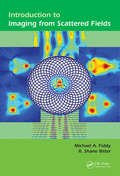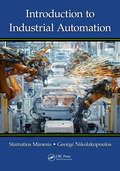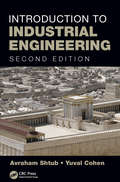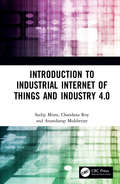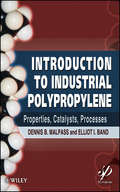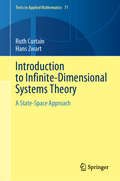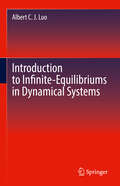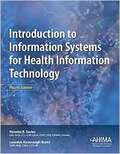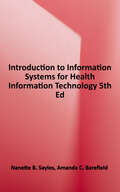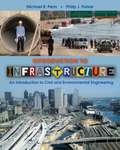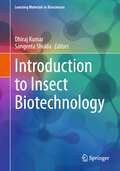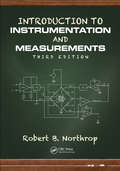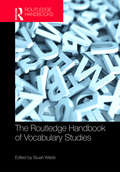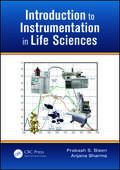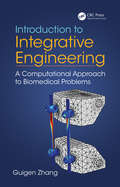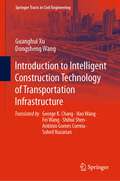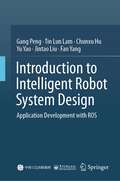- Table View
- List View
Introduction to Hypoplasticity: Advances in Geotechnical Engineering and Tunnelling 1
by D. KolymbasThis book aims to give the reader a short, tractable and as far as possible complete introduction to the young theory of hypoplasticity, which is a new approach to constitutive modelling of granular media in terms of rational continuum mechanics.
Introduction to Image Acquisition and Display Technologies: Photon manipulation in image sensors and displays
by Ichiro FujiedaIn this valuable reference work, Ichiro Fujieda focuses on the component technologies, device configurations, and operation principles of image acquisition and display technologies and provides detailed use cases to give practical guidance on the various current and potential future applications of these technologies. The technology and the physics behind these devices can be grouped into three categories: optical technology, material science, and semiconductor device technology. This book enables readers to gain an understanding of these three areas in relation to the flow of image information and several example applications of the technology. Fujieda first describes the building blocks of image sensors and displays (detectors, light sources, transistors, and wavefront control devices) and their configurations, operation principles, and characteristics. He then describes in more detail image sensor technology (including MOS image sensors, CCD technologies, and X-ray and infrared imagers) and displays (including thin-film transistor arrays, LCDs, OLEDs, MEMS devices, and more). Finally, he provides real-world examples of how these technologies are used together to give the reader an understanding of their practical applications and their potential use in future devices. Some important laws in optics and definitions in color science are included for easy reference. Through this approach, the reader will gain a detailed understanding of each of the component parts of existing imaging devices and will be able to apply this to future developments within the field. This book will benefit any advanced undergraduate and graduate student and industry professional who wishes to expand his or her understanding of the hardware handling digital images. Some basic knowledge is required on semiconductor device physics and the interaction of radiation with matter, though these are described in the appropriate sections.
Introduction to Image Processing and Analysis
by John C. Russ J. Christian Russ<p>Image processing comprises a broad variety of methods that operate on images to produce another image. A unique textbook, Introduction to Image Processing and Analysis establishes the programming involved in image processing and analysis by utilizing skills in C compiler and both Windows and MacOS programming environments. The provided mathematical background illustrates the workings of algorithms and emphasizes the practical reasons for using certain methods, their effects on images, and their appropriate applications. The text concentrates on image processing and measurement and details the implementation of many of the most widely used and most important image processing and analysis algorithms. <p>Homework problems are included in every chapter with solutions available for download from the CRC Press website. The chapters work together to combine image processing with image analysis. The book begins with an explanation of familiar pixel array and goes on to describe the use of frequency space. Chapters 1 and 2 deal with the algorithms used in processing steps that are usually accomplished by a combination of measurement and processing operations, as described in chapters 3 and 4. The authors present each concept using a mixture of three mutually supportive tools: a description of the procedure with example images, the relevant mathematical equations behind each concept, and the simple source code (in C), which illustrates basic operations. In particularly, the source code provides a starting point to develop further modifications. <p>Written by John Russ, author of esteemed Image Processing Handbook now in its fifth edition, this book demonstrates functions to improve an image's of features and detail visibility, improve images for printing or transmission, and facilitate subsequent analysis.</p>
Introduction to Imaging from Scattered Fields
by Michael A Fiddy R. Shane RitterObtain the Best Estimate of a Strongly Scattering Object from Limited Scattered Field DataIntroduction to Imaging from Scattered Fields presents an overview of the challenging problem of determining information about an object from measurements of the field scattered from that object. It covers widely used approaches to recover information about th
Introduction to Industrial Automation
by Stamatios Manesis George NikolakopoulosThis book provides an extended overview and fundamental knowledge in industrial automation, while building the necessary knowledge level for further specialization in advanced concepts of industrial automation. It covers a number of central concepts of industrial automation, such as basic automation elements, hardware components for automation and process control, the latch principle, industrial automation synthesis, logical design for automation, electropneumatic automation, industrial networks, basic programming in PLC, and PID in the industry.
Introduction to Industrial Engineering (Systems Innovation Book Series)
by Avraham Shtub Yuval CohenA Firsthand Look at the Role of the Industrial EngineerThe industrial engineer helps decide how best to utilize an organization’s resources to achieve company goals and objectives. Introduction to Industrial Engineering, Second Edition offers an in-depth analysis of the industrial engineering profession. While also providing a historical perspective chronicling the development of the profession, this book describes the standard duties performed, the tools and terminologies used, and the required methods and processes needed to complete the tasks at hand. It also defines the industrial engineer’s main areas of operation, introduces the topic of information systems, and discusses their importance in the work of the industrial engineer. The authors explain the information system concept, and the need for integrated processes, supported by modern information systems. They also discuss classical organizational structures (functional organization, project organization, and matrix organization), along with the advantages and disadvantages of their use. The book includes the technological aspects (data collection technologies, databases, and decision-support areas of information systems), the logical aspects (forecasting models and their use), and aspects of principles taken from psychology, sociology, and ergonomics that are commonly used in the industry. What’s New in this Edition:The second edition introduces fields that are now becoming a part of the industrial engineering profession, alongside conventional areas (operations management, project management, quality management, work measurement, and operations research). In addition, the book: Provides an understanding of current pathways for professional development Helps students decide which area to specialize in during the advanced stages of their studies Exposes students to ergonomics used in the context of workspace design Presents key factors in human resource management Describes frequently used methods of teaching in the field Covers basic issues relative to ergonomics and human–machine interface Introduces the five basic processes that exist in many organizations Introduction to Industrial Engineering, Second Edition establishes industrial engineering as the organization of people and resources, describes the development and nature of the profession, and is easily accessible to anyone needing to learn the basics of industrial engineering. The book is an indispensable resource for students and industry professionals.
Introduction to Industrial Internet of Things and Industry 4.0
by Sudip Misra Chandana Roy Anandarup MukherjeeIndustrial IoT (IIoT) and Industry 4.0 are newly developing and fast emerging domains of interest among students, researchers, and professionals in academia and industry. Due to the popular demand of this topic, Introduction to Industrial Internet of Things and Industry 4.0 is written to serve a diverse readership from the domains of computer science and engineering, mechanical engineering, information technology, industrial engineering, electronics engineering, and other related branches of engineering. Based on the lead author’s massive open online courses (MOOCs), this book can be used as a textbook on the emerging paradigm of Industry 4.0 and IIoT, as well as a reference for professionals working in sectors of IIoT. The book covers the significant aspects of IIoT in detail, including sensors, actuators, data transmission, and data acquisition, which form the core of IIoT. Topics and concepts are presented in a comprehensive manner, so that readers can develop expertise and knowledge. The book helps beginners to gain a basic idea of Industry 4.0 and IIoT as the first section is an overview of IoT applications, infrastructure-based protocols, cloud computing, and fog computing. The second section is designed to impart a basic knowledge of Industry 4.0 and IIoT as well as of the different phases of development in industry. Delving into more advanced areas, other sections in the book cover: The business models and reference architecture of IIoT The technological aspects of Industry 4.0 and IIoT Predictive and prescriptive analytics applied in IIoT-based implementations Applications and case studies of IIoT Key enabling technologies of IIoT To aid students and professional master IIoT and Industry 4.0, the book includes conceptual questions, exercises, and learning objectives.
Introduction to Industrial Polypropylene
by Dennis B. Malpass Elliot BandThis introductory text is an important resource for new engineers, chemists, students, and chemical industry personnel to understand the technical aspects of polypropylene which is the 2nd largest synthetics polymer in manufactured output. The book considers the following topics:What are the principal types of polypropylene and how do they differ? What catalysts are used to produce polypropylene and how do they function? What is the role of cocatalysts and how have they evolved over the years? How are industrial polypropylene catalysts tested and the resultant polymer evaluated? What processes are used in the manufacture of polypropylene? What are the biopolymer alternatives to polypropylene? What companies are the major industrial manufacturers of polypropylene? What is the environmental fate of polypropylene?
Introduction to Infinite-Dimensional Systems Theory: A State-Space Approach (Texts in Applied Mathematics #71)
by Hans Zwart Ruth CurtainInfinite-dimensional systems is a well established area of research with an ever increasing number of applications. Given this trend, there is a need for an introductory text treating system and control theory for this class of systems in detail. This textbook is suitable for courses focusing on the various aspects of infinite-dimensional state space theory. This book is made accessible for mathematicians and post-graduate engineers with a minimal background in infinite-dimensional system theory. To this end, all the system theoretic concepts introduced throughout the text are illustrated by the same types of examples, namely, diffusion equations, wave and beam equations, delay equations and the new class of platoon-type systems. Other commonly met distributed and delay systems can be found in the exercise sections. Every chapter ends with such a section, containing about 30 exercises testing the theoretical concepts as well. An extensive account of the mathematical background assumed is contained in the appendix.
Introduction to Infinite-Equilibriums in Dynamical Systems
by Albert C.J LuoThis book examines infinite-equilibriums for the switching bifurcations of two 1-dimensional flows in dynamical systems. Quadratic single-linear-bivariate systems are adopted to discuss infinite-equilibriums in dynamical systems. For such quadratic dynamical systems, there are three types of infinite-equilibriums. The inflection-source and sink infinite-equilibriums are for the switching bifurcations of two parabola flows on the two-directions. The parabola-source and sink infinite-equilibriums are for the switching bifurcations of parabola and inflection flows on the two-directions. The inflection upper and lower-saddle infinite-equilibriums are for the switching bifurcation of two inflection flows in two directions. The inflection flows are for appearing bifurcations of two parabola flows on the same direction. Such switching bifurcations for 1-dimensional flow are based on the infinite-equilibriums, which will help one understand global dynamics in nonlinear dynamical systems. This book introduces infinite-equilibrium concepts and such switching bifurcations to nonlinear dynamics.
Introduction to Information Systems for Health Information Technology
by Lauralyn Kavanaugh-Burke Nanette SaylesHealth information management (HIM) students and professionals must learn everything they can about the basics of electronic health records (EHRs), general healthcare computer systems, data retrieval, and other EHR system topics. Introduction to Information Systems focuses on how these systems and issues affect, and are affected by, the HIM profession. Updated with current information technology (IT) content that reflects the healthcare environment, Introduction to Information Systems explains the growing wealth of health data and information available to HIM practitioners and what it can do for patients and society while also explaining the responsibility to secure these assets.
Introduction to Information Systems for Health Information Technology, 5th Edition
by Nanette B. Sayles Amanda C. BarefieldHealth information management (HIM) students and professionals must learn everything they can about the basics of electronic health records (EHRs), general healthcare computer systems, data retrieval, and other EHR system topics. This text helps readers gain an understanding of how these systems and issues affect, and are affected by, the HIM profession. Updated to reflect current information technology (IT) content in the healthcare environment relevant to both scholars and professionals, this fifth edition of Introduction to Information Systems for Health Information Technology explains the growing wealth of health data and information available to HIM practitioners and what it can do for patients and society, while also explaining the responsibility to secure these assets. This edition emphasizes practical applications within the HIM profession, offering revised real-world scenarios and practice opportunities. Key Features: - New online student workbook - Real-World Cases and Check Your Understanding questions in each chapter - Updated privacy and security information and best practices
Introduction to Infrastructure: An Introduction to Civil and Environmental Engineering
by Philip J. Parker Michael R. PennIntroduction to Infrastructure: An Introduction to Civil andEnvironmental Engineering breaks new ground in preparingcivil and environmental engineers to meet the challenges of the21st century.
Introduction to Insect Biotechnology (Learning Materials in Biosciences)
by Dhiraj Kumar Sangeeta ShuklaThis textbook introduces to the fundamentals and applications of insect biotechnology in a concise manner. Global economically important insects such as silkworm, lac or honey bee are in the focus of this text. The book attempts to address all of the latest developments in this growing field such as application of metagenomics and proteomics in mining for genes and enzymes that could be beneficial in diverse industrial and biomedical applications. Further, insects have been established as suitable tool for the production of transgenic products which is discussed in one dedicated chapter. The book targets students and researchers in molecular biology, biotechnology or entomology who want to get familiar with the emerging field of insect biotechnology.
Introduction to Instrumentation and Measurements
by Robert B. NorthropWeighing in on the growth of innovative technologies, the adoption of new standards, and the lack of educational development as it relates to current and emerging applications, the third edition of Introduction to Instrumentation and Measurements uses the authors’ 40 years of teaching experience to expound on the theory, science, and art of modern instrumentation and measurements (I&M). What’s New in This Edition: This edition includes material on modern integrated circuit (IC) and photonic sensors, micro-electro-mechanical (MEM) and nano-electro-mechanical (NEM) sensors, chemical and radiation sensors, signal conditioning, noise, data interfaces, and basic digital signal processing (DSP), and upgrades every chapter with the latest advancements. It contains new material on the designs of micro-electro-mechanical (MEMS) sensors, adds two new chapters on wireless instrumentation and microsensors, and incorporates extensive biomedical examples and problems. Containing 13 chapters, this third edition: Describes sensor dynamics, signal conditioning, and data display and storage Focuses on means of conditioning the analog outputs of various sensors Considers noise and coherent interference in measurements in depth Covers the traditional topics of DC null methods of measurement and AC null measurements Examines Wheatstone and Kelvin bridges and potentiometers Explores the major AC bridges used to measure inductance, Q, capacitance, and D Presents a survey of sensor mechanisms Includes a description and analysis of sensors based on the giant magnetoresistive effect (GMR) and the anisotropic magnetoresistive (AMR) effect Provides a detailed analysis of mechanical gyroscopes, clinometers, and accelerometers Contains the classic means of measuring electrical quantities Examines digital interfaces in measurement systems Defines digital signal conditioning in instrumentation Addresses solid-state chemical microsensors and wireless instrumentation Introduces mechanical microsensors (MEMS and NEMS) Details examples of the design of measurement systems Introduction to Instrumentation and Measurements is written with practicing engineers and scientists in mind, and is intended to be used in a classroom course or as a reference. It is assumed that the reader has taken core EE curriculum courses or their equivalents.
Introduction to Instrumentation and Measurements
by Robert B. NorthropWeighing in on the growth of innovative technologies, the adoption of new standards, and the lack of educational development as it relates to current and emerging applications, the third edition of Introduction to Instrumentation and Measurements uses the authors’ 40 years of teaching experience to expound on the theory, science, and art of modern instrumentation and measurements (I&M). What’s New in This Edition: This edition includes material on modern integrated circuit (IC) and photonic sensors, micro-electro-mechanical (MEM) and nano-electro-mechanical (NEM) sensors, chemical and radiation sensors, signal conditioning, noise, data interfaces, and basic digital signal processing (DSP), and upgrades every chapter with the latest advancements. It contains new material on the designs of micro-electro-mechanical (MEMS) sensors, adds two new chapters on wireless instrumentation and microsensors, and incorporates extensive biomedical examples and problems. Containing 13 chapters, this third edition: Describes sensor dynamics, signal conditioning, and data display and storage Focuses on means of conditioning the analog outputs of various sensors Considers noise and coherent interference in measurements in depth Covers the traditional topics of DC null methods of measurement and AC null measurements Examines Wheatstone and Kelvin bridges and potentiometers Explores the major AC bridges used to measure inductance, Q, capacitance, and D Presents a survey of sensor mechanisms Includes a description and analysis of sensors based on the giant magnetoresistive effect (GMR) and the anisotropic magnetoresistive (AMR) effect Provides a detailed analysis of mechanical gyroscopes, clinometers, and accelerometers Contains the classic means of measuring electrical quantities Examines digital interfaces in measurement systems Defines digital signal conditioning in instrumentation Addresses solid-state chemical microsensors and wireless instrumentation Introduces mechanical microsensors (MEMS and NEMS) Details examples of the design of measurement systems Introduction to Instrumentation and Measurements is written with practicing engineers and scientists in mind, and is intended to be used in a classroom course or as a reference. It is assumed that the reader has taken core EE curriculum courses or their equivalents.
Introduction to Instrumentation and Measurements (Studies In Mathematical Thinking And Learning Ser.)
by Robert B. NorthropWeighing in on the growth of innovative technologies, the adoption of new standards, and the lack of educational development as it relates to current and emerging applications, the third edition of Introduction to Instrumentation and Measurements uses the authors’ 40 years of teaching experience to expound on the theory, science, and art of modern instrumentation and measurements (I&M). What’s New in This Edition: This edition includes material on modern integrated circuit (IC) and photonic sensors, micro-electro-mechanical (MEM) and nano-electro-mechanical (NEM) sensors, chemical and radiation sensors, signal conditioning, noise, data interfaces, and basic digital signal processing (DSP), and upgrades every chapter with the latest advancements. It contains new material on the designs of micro-electro-mechanical (MEMS) sensors, adds two new chapters on wireless instrumentation and microsensors, and incorporates extensive biomedical examples and problems. Containing 13 chapters, this third edition: Describes sensor dynamics, signal conditioning, and data display and storage Focuses on means of conditioning the analog outputs of various sensors Considers noise and coherent interference in measurements in depth Covers the traditional topics of DC null methods of measurement and AC null measurements Examines Wheatstone and Kelvin bridges and potentiometers Explores the major AC bridges used to measure inductance, Q, capacitance, and D Presents a survey of sensor mechanisms Includes a description and analysis of sensors based on the giant magnetoresistive effect (GMR) and the anisotropic magnetoresistive (AMR) effect Provides a detailed analysis of mechanical gyroscopes, clinometers, and accelerometers Contains the classic means of measuring electrical quantities Examines digital interfaces in measurement systems Defines digital signal conditioning in instrumentation Addresses solid-state chemical microsensors and wireless instrumentation Introduces mechanical microsensors (MEMS and NEMS) Details examples of the design of measurement systems Introduction to Instrumentation and Measurements is written with practicing engineers and scientists in mind, and is intended to be used in a classroom course or as a reference. It is assumed that the reader has taken core EE curriculum courses or their equivalents.
Introduction to Instrumentation in Life Sciences
by Prakash Singh Bisen Anjana SharmaInstrumentation is central to the study of physiology and genetics in living organisms, especially at the molecular level. Numerous techniques have been developed to address this in various biological disciplines, creating a need to understand the physical principles involved in the operation of research instruments and the parameters required in u
Introduction to Integrative Engineering: A Computational Approach to Biomedical Problems
by Guigen ZhangThis textbook is designed for an introductory course at undergraduate and graduate levels for bioengineering students. It provides a systematic way of examining bioengineering problems in a multidisciplinary computational approach. The book introduces basic concepts of multidiscipline-based computational modeling methods, provides detailed step-by-step techniques to build a model with consideration of underlying multiphysics, and discusses many important aspects of a modeling approach including results interpretation, validation, and assessment.
Introduction to Intelligent Construction Technology of Transportation Infrastructure (Springer Tracts in Civil Engineering)
by Dongsheng Wang Guanghui XuThis book expounds on the related technologies of intelligent transportation infrastructure construction. Based on the essential characteristics of intelligent construction, "perception, analysis, decision-making, and execution," the basic structure of intelligent construction technology (ICT) is established. With the integration of engineering construction technologies, the analyses of the essence of intelligent algorithms and the feasibility of Artificial Intelligence (AI) are provided. The book introduces the essential characteristics of Big Data and the Internet of Things and their relationship with engineering construction. On this basis, the feasibility and implementation plan of intelligent technology applications in design, construction, and maintenance are analyzed and demonstrated with engineering examples. The book also combines ICT with intelligent construction talent training, the professional knowledge required for intelligent construction, and the theoretical basis to provide the methods for mastering new technologies. This book can be used by technical personnel in related fields such as highways, railways, airports, and urban road construction to understand and master innovative, intelligent construction technologies. It can also be a reference book for ICT-related college courses.
Introduction to Intelligent Robot System Design: Application Development with ROS
by Fan Yang Yu Yao Gang Peng Tin Lun LAM Chunxu Hu Jintao LiuThis book introduces readers to the principles and practical applications of intelligent robot system with robot operating system (ROS), pursuing a task-oriented and hands-on approach. Taking the conception, design, implementation, and operation of robot application systems as a typical project, and through “learning-by-doing, practicing-while-learning” approach, it familiarizes readers with ROS-based intelligent robot system design and development step by step.The topics covered include ROS principles, mobile robot control, Lidar, simultaneous localization and mapping (SLAM), navigation, manipulator control, image recognition, vision calibration, object grasping, vision SALM, etc., with typical practical application tasks throughout the book, which are essential to mastering development methods for intelligent robot system.Easy to follow and rich in content, the book can be used at colleges and universities as learning material and a teaching reference book for “intelligent robot,” “autonomous intelligent system,” “robotics principles,” and “robot system application development with ROS” in connection with automation, robotics engineering, artificial intelligence (AI), mechatronics, and other related majors. The book can assist in mastering the development and design of robot systems and provide the necessary theoretical and practical references to cultivate robot system development capabilities and can be used as teaching material for engineering training and competitions, or for reference, self-study, and training by engineering and technical personnel, teachers, and anyone who wants to engage in intelligent robot system development and design.
Introduction to Intelligent Surveillance
by Wei Qi YanThis concise textbook examines the fundamental aspectsof intelligent computing for surveillance systems, from camera calibration anddata capturing, to secure data transmission. The text covers digital surveillancefrom the level of an individual object or biometric feature, to the fulllifecycle of an event. This is followed by a detailed discussion on how anintelligent system can independently monitor and learn from an event, andinvite human input when necessary. The book concludes with a presentation onhow the system can be enhanced through the use of supercomputing technology. Features:contains exercises at the end of every chapter, and a glossary; covers the keyissues of computer network infrastructure, security, monitoring and forensics,and the essential aspects of object analysis; reviews algorithms forsurveillance data analytics using biometric features; discusses the use of AI forsurveillance events; reviews algorithms that trigger an alarm to alert a memberof security staff.
Introduction to Intelligent Surveillance
by Wei Qi YanThis concise textbook examines the fundamental aspects of intelligent computing for surveillance systems, from camera calibration and data capturing, to secure data transmission. The text covers digital surveillance from the level of an individual object or biometric feature, to the full lifecycle of an event. This is followed by a detailed discussion on how an intelligent system can independently monitor and learn from an event, and invite human input when necessary. The book concludes with a presentation on how the system can be enhanced through the use of supercomputing technology. Features: contains exercises at the end of every chapter, and a glossary; covers the key issues of computer network infrastructure, security, monitoring and forensics, and the essential aspects of object analysis; reviews algorithms for surveillance data analytics using biometric features; discusses the use of AI for surveillance events; reviews algorithms that trigger an alarm to alert a member of security staff.
Introduction to International Disaster Management (Second Edition)
by Damon P. CoppolaIntroduction to International Disaster Management, Second Edition continues to serve as the sole comprehensive overview of global emergency management This second edition contains updated information on disaster trends as well as on management structures and advancements around the world Coppola includes changes that reflect the dual theme of the book: universal principles of global emergency management practice and advances in the field worldwide, and lessons from disasters and other watershed events that have occurred since the first edition was published This text includes new case studies and updated disaster, risk, and vulnerability data, as well as insightful discussions of recent national and international initiatives, and of progress towards improving non-governmental organization (NGO) and private sector cooperation and professionalism. This text approaches the practice of emergency management from a global perspective, making it the only introductory book without bias towards the emergency management system or history of a single country or region. * Serves as the first comprehensive resource dealing with the issues of international disaster management * Contains numerous case studies, examples of Best Practices in international disaster management, and a contact list of the governmental and nongovernmental agencies involved in international disaster management * Provides a global perspective on risk, hazards, and disasters that is written both for students within disaster management programs and for professionals entering the field.
Introduction to Internet of Things (River Publishers Series in Rapids in Computing and Information Science and Technology)
by Ahmed BanafaThis book introduces the Internet of Things (IoT), which is the convergence of connecting people, things, data and processes; it is transforming our life, business and everything in between. By 2025, experts forecast that up to 75 billion devices will be connected to the Internet with only one third of them being computers, smartphones, smartwatches, and tablets. The remaining two thirds will be other "devices" – sensors, terminals, household appliances, thermostats, televisions, automobiles, production machinery, urban infrastructure and many other "things", which traditionally have not been Internet enabled. This "Internet of Things" (IoT) represents a remarkable transformation of the way in which our world will soon interact. Much like the World Wide Web connected computers to networks, and the next evolution mobile devices connected people to the Internet and other people, IoT looks poised to interconnect devices, people, environments, virtual objects and machines in ways that only science fiction writers could have imagined.
